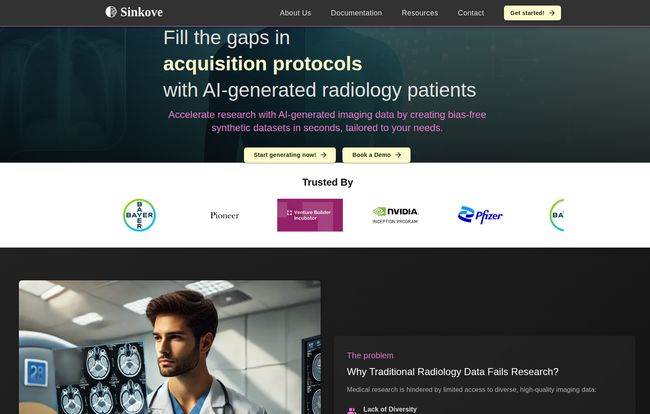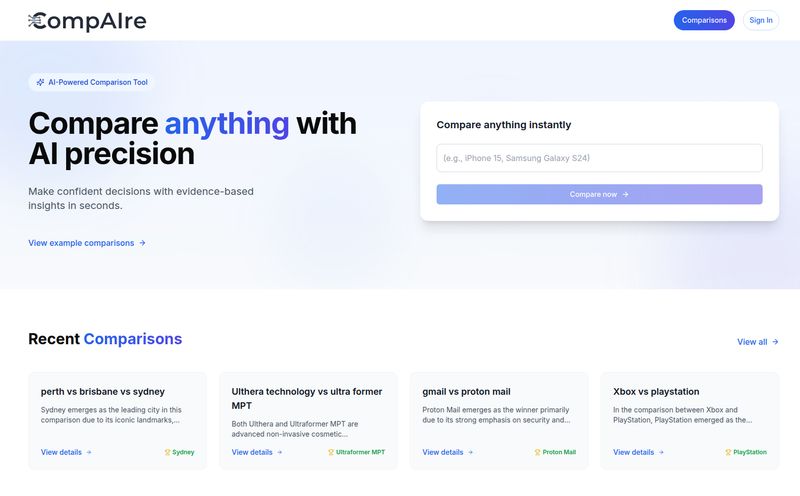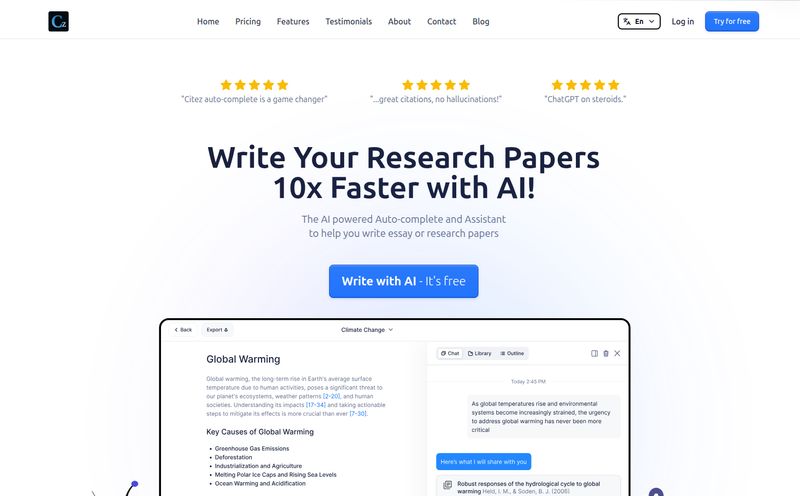As someone who lives and breathes data, I’ve seen my fair share of messy datasets. In the world of marketing and SEO, bad data means a botched campaign or a tanking CPC. Frustrating, for sure. But in medical research? Bad data can stall life-saving innovations for years. It’s a whole different ball game.
For decades, the gold standard for medical AI and research has been real patient data. But getting it is a slog. It's expensive, it’s slow, and worst of all, it's often incredibly biased. If your data only represents one demographic, how can you build a tool that works for everyone? It's a problem that has plagued healthcare for, well, forever. I've always felt it's one of those 'unsolvable' issues we just have to work around.
Then I stumbled upon a platform called Sinkove. And my first thought was, “Wait, what?” They’re not just trying to clean up the data. They’re creating it from scratch with generative AI. It sounds like science fiction, but the more I looked into it, the more it started to feel like the most practical solution I’ve seen in a long time.
The Old Way of Doing Things is Broken
Before we get into the nuts and bolts of Sinkove, let's just sit with the problem for a second. Why is traditional radiology data failing us? The images on Sinkove's own site spell it out pretty clearly.
- Lack of Diversity: This is the big one. Most available medical imaging data comes from specific populations, leaving massive gaps. An AI trained on this data might be great at spotting a condition in a 55-year-old white male but completely miss it in a 30-year-old black female. It's a huge blind spot.
- Insane Recruitment Times: Finding and enrolling eligible patients for a study can take months, sometimes years. It’s a logistical nightmare that slows the entire pace of innovation to a crawl.
- The Cost: I mean, this one’s a no-brainer. Patient recruitment is ridiculously expensive. Each data point comes with a hefty price tag, limiting the scope of what many researchers can even attempt to do.
It’s like trying to build a perfect, life-size replica of a car when you've only been given a few photos of the left tire and a grainy sketch of the steering wheel. You're just not going to get it right.

Visit Sinkove
So, What is Sinkove's AI-Powered Solution?
Sinkove’s approach is fundamentally different. Instead of panning for those rare flecks of gold in the river of real-world data, they’ve built a mint. They use generative AI—the same kind of tech behind mind-blowing art generators—to create high-quality, synthetic biomedical images. Think of it as creating a “digital twin” of a patient. You get all the anatomical detail and pathological accuracy, but without the real-world constraints.
This isn't just about making fake X-rays. It's about generating entire datasets of synthetic patients tailored to a researcher’s exact needs. Need to test your AI on images of a rare disease subtype across a dozen different ethnicities and age groups? Traditionally, that would be nearly impossible. With Sinkove, it’s a matter of defining your parameters and letting the AI do the heavy lifting.
How This AI Magic Actually Works
The process, at a high level, is surprisingly straightforward. They’ve broken it down into four main steps:
- Customise: This is where the researcher defines what they need. They can specify patient demographics, disease characteristics, and even the type of imaging equipment used. It's about setting the recipe for your perfect dataset.
- Generate: The AI gets to work, creating diverse and hyper-realistic images that match the custom specs. The platform can generate countless variations, filling in the gaps that real-world data collection could never hope to cover.
- Measure: This step is so important. Creating data is one thing; proving it's accurate is another. Sinkove validates the synthetic data to ensure it meets quality, reliability, and even regulatory compliance standards. This isn't just for show—it's for building trust.
- Integrate: Finally, the newly minted, high-quality dataset is ready to be plugged directly into existing research workflows. No weird formats or clunky software. It’s designed to just... work.
The Real-World Impact of Synthetic Data
Okay, so the tech is cool. But what does it actually do? The benefits are where things get really exciting for anyone in the medical or AI fields.
Tackling the Bias Monster Head-On
By generating data that reflects true global diversity, Sinkove directly addresses the systemic bias in medical AI. This means we can build diagnostic tools that are more equitable and effective for everyone, regardless of their background. In my opinion, this is probably the most profound benefit of the whole platform.
Putting Research on the Fast Track
Remember those research timelines that stretched on for years? By replacing the need for real-world patient recruitment with on-demand data generation, Sinkove can turn years into weeks. Or even days. This acceleration could dramatically shorten the time it takes for new medical breakthroughs to reach patients. The cost savings are also a huge factor, opening the door for smaller labs and startups to compete with the big guys—something we've seen happen in other tech sectors thanks to more accessible tools.
Standardization is the Unsung Hero
Anyone who has tried to merge datasets from two different hospitals knows the pain. Different machines, different protocols, different everything. It creates noise and variability. Sinkove standardizes everything. It can generate data as if it all came from the same machine under the same conditions, creating a cleaner, more reliable foundation for training AI models.
Is There a Catch? Let's Talk Caveats
Now, I’m a professional skeptic. No solution is perfect, right? And Sinkove is no exception. There are a few things to keep in mind.
First, the synthetic data requires rigorous validation. You can’t just trust that the AI got it right. The platform has processes for this, but it’s a critical step that can’t be skipped. You need to be sure the synthetic images are clinically and anatomically correct, especially when you're heading toward regulatory approvals. You can't just 'wing it' with this stuff.
Second, while they offer pre-trained models, some use cases might require customization. This isn't a huge drawback, more of a reality of working with complex data. It might take some work to fine-tune the AI to generate the exact kind of specific data you need.
And finally, the whole system’s effectiveness hinges on the accuracy of the underlying AI models. It's a classic “Garbage In, Garbage Out” scenario, but at a much higher level. The quality of the synthetic data is only as good as the AI that creates it. That said, with backers like NVIDIA and Pfizer, you have to assume their models are pretty darn robust.
What's the Price Tag on Innovation?
This is the part where I'd usually drop a pricing table. But for Sinkove, there isn't one. And that makes sense. This isn't a simple SaaS tool with a $20/month plan. It's an enterprise-level solution for major research institutions, pharmaceutical companies, and AI developers.
To get pricing information, you’ll need to contact their team and book a demo. They’ll work with you to understand your needs and provide a custom quote. It's a high-touch sales process for a high-impact product.
Frequently Asked Questions about Sinkove
What exactly is synthetic biomedical data?
Think of it as artificially generated information that has the same mathematical properties and patterns as real-world data, but doesn't contain any identifiable information from real individuals. In Sinkove's case, it's AI-created medical images (like X-rays or MRIs) that are realistic and accurate but aren't from an actual person.
Is synthetic data from Sinkove reliable enough for clinical research?
That's the goal. The platform includes a crucial 'Measure' step to validate the generated images for accuracy, reliability, and regulatory compliance. While it shouldn't be seen as a 1-for-1 replacement for real patient trials in all contexts, it's designed to be a highly reliable tool for training AI models and accelerating the early-to-mid stages of research.
Who would benefit most from using Sinkove?
The primary users would be pharmaceutical companies, university research centers, medical AI startups, and any organization involved in clinical research or the development of healthcare AI. Basically, anyone who needs large, diverse, and high-quality medical imaging datasets.
How does Sinkove handle data privacy?
This is one of the biggest advantages of synthetic data. Because the images are generated by an AI and not tied to real patients, it inherently sidesteps many of the privacy and HIPAA concerns associated with using real patient records. It provides a way to innovate while protecting patient confidentiality.
Does this technology replace real patients in research entirely?
No, not entirely. It's a tool to augment and accelerate research, not eliminate it. It's incredibly powerful for training and validating AI models, exploring hypotheses, and filling data gaps. However, late-stage clinical trials involving real human subjects will likely always be a necessary final step before a new treatment or diagnostic tool is approved for public use.
My Final Take: A New Era for Medical Data?
Look, the hype around AI can be exhausting. But every now and then, a company applies it to a real, stubborn problem in a way that just makes sense. Sinkove feels like one of those. It’s not just a flashy new toy; it’s a pickaxe and a shovel for researchers who have been trying to dig for gold with their bare hands.
By tackling the foundational issues of data scarcity, bias, and cost, Sinkove isn't just offering a new product. They’re offering a new way of thinking about research itself. It's a bold move, and if they can deliver on their promises, it could genuinely change the speed at which we innovate in medicine. And that’s something to get excited about.
Reference and Sources
- Sinkove Official Website: https://www.sinkove.com/



